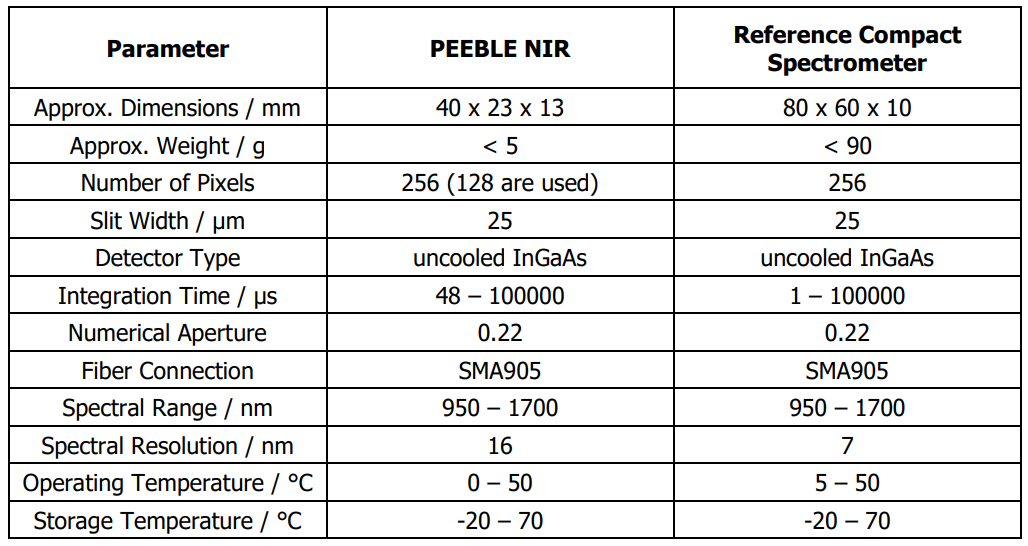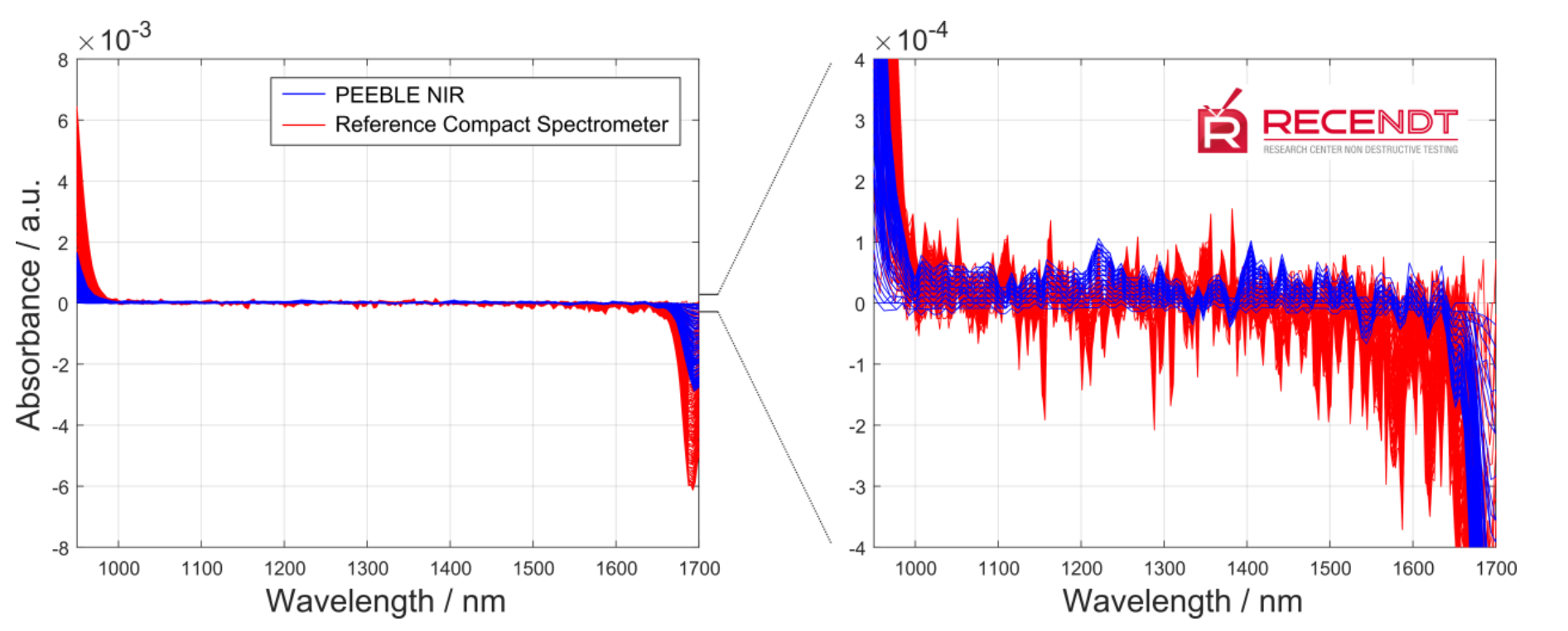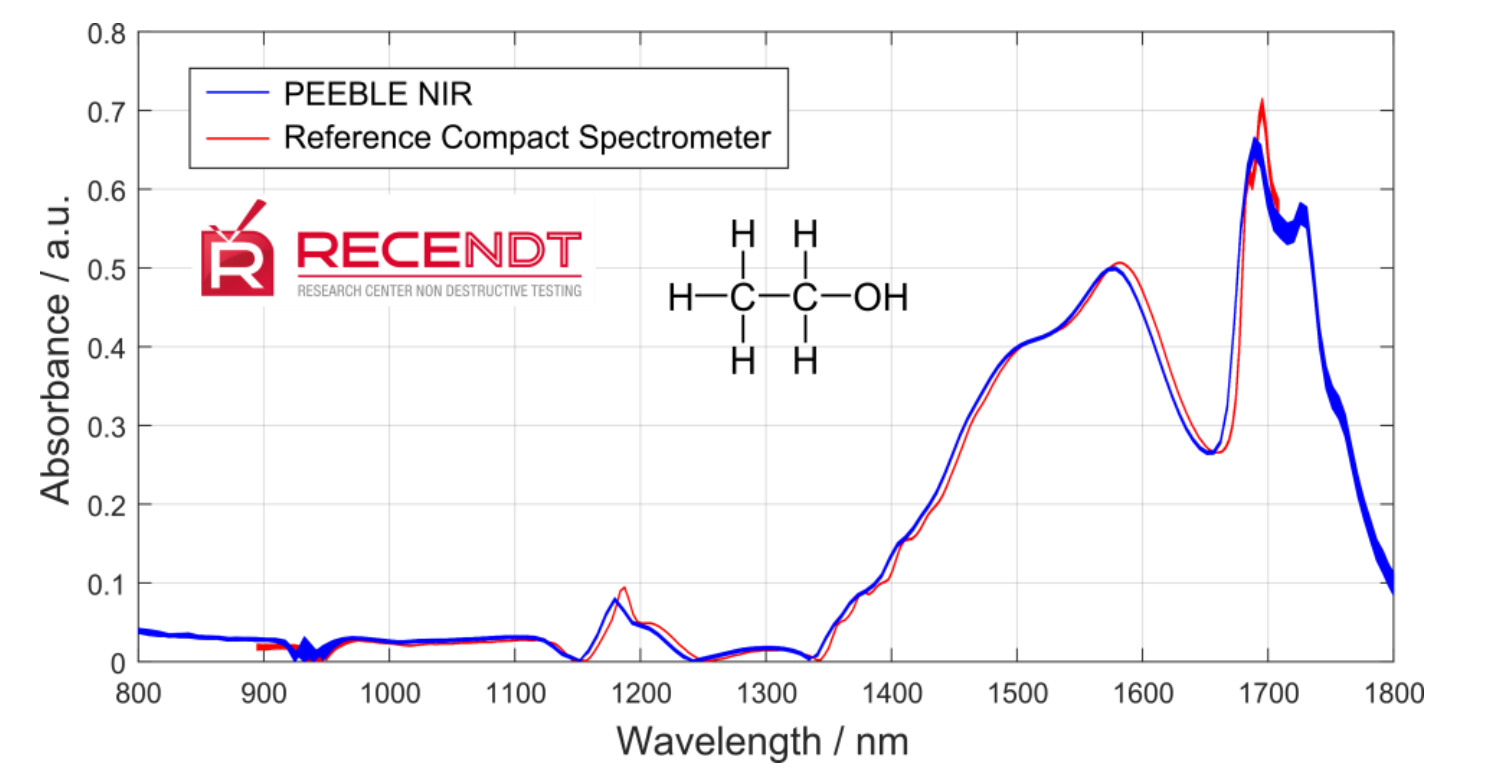Performance Comparison: Ibsen Photonics PEBBLE NIR (PBM-400) vs. similar Compact Spectrometer
This comparison was conducted and the report written by Robert Zimmerleiter from RECENDT – Research Center for Non-Destructive Testing GmbH on March 2nd, 2022.
In this document, the findings from comparative measurements carried out with a PEBBLE NIR spectrometer and a comparable compact spectrometer for reference are summarized.
Device Specifications
The table below shows a comparison of some important specifications of each device:

For an experimental comparison, a simple setup as shown in Figure 1 was used (taken from
Zimmerleiter et al. https://publikationen.bibliothek.kit.edu/1000128686, 2021).

Figure 1: Schematic drawing of the experimental setup used for the conducted comparison
measurements.
For connecting both spectrometers, a round to linear fiber was used and carefully aligned to illuminate as much of the entrance slit as possible. The exposure time was set to a level that was only slightly below saturation of the detector (with no sample present). Then averaging was adjusted to get a measurement duration
(including storing the data on the PC hard drive) of approximately 2 seconds. The results for both devices are:
PEBBLE NIR:
Exposure time = 370 µs
Averaging = 2000
Reference compact spectrometer:
Exposure time = 800 µs
Averaging = 30
It seems that the PEEBLE NIR spectrometer outperforms the reference compact spectrometer when it comes to data transfer speed. This is most likely due to the possibility of averaging spectra directly in hardware, which was not possible with the other compact spectrometer.
100% Lines
To test for the noise level, the light straight from the halogen lamp was measured (no cuvette). 101 spectra measured straight from the halogen light source were acquired for each spectrometer. The first measured spectrum (S0) was used as background and 100 individual 100%-lines were calculated with the formula below:

The 100%-lines for the two devices (200 lines in total) are shown in Figure 2. The left graph is a zoomed version of the one on the right side.
To compare the noise performance of the two spectrometers the root mean square was calculated according to:

where Nλ is the total number of spectral points acquired.
The RMS-values of the two spectrometers are:
RMSPEEBLE = 1.03 x 10-4
RMSCOMP = 2.28 x 10-4
From the RMS values it can be seen, that the PEEBLE outperforms the reference compact spectrometer by approximately a factor of 2 when it comes to noise performance. However, it offers only approximately half the spectral resolution.

Figure 2: 100% Lines of the PEEBLE NIR compared to the reference compact spectrometer with similar specifications.
To make the spectra more comparable, a smoothing filter (Savitzky-Golay, 3 points) was applied to the compact spectrometer data. This gave spectra with half the spectral resolution, which are comparable to the PEBBLE. The resulted RMS of approximately 2.20 x 10-4 was only slightly better. A significant increase in performance is gained when using only the data between 1000 nm and 1650 nm, resulting in an RMS of 2.71 x 10-5 for the PEBBLE NIR and an RMS of 5.39 x 10-5 (4.62 x 10-5 with Savitzky-Golay filter) for the reference compact spectrometer.
Absorption Spectrum of Ethanol
A real-world comparison was done by acquiring 100 transmission spectra of ethanol in a quartz-glass cuvette with a pathlength of 1 mm with each instrument. The empty cuvette was used as a background. The resulting spectra (200 in total) are shown Figure 3.

Figure 3: Absorption of ethanol measured in a quartz-glass cuvette with 1 mm path length.
The acquired spectra agree nicely, with a slight offset of approximately 5 nm. However, due to the lower spectral resolution of the PEBBLE NIR some spectral features are not as clearly visible in the absorption spectra as with the reference compact spectrometer.
Want to know more?
For further information see below.